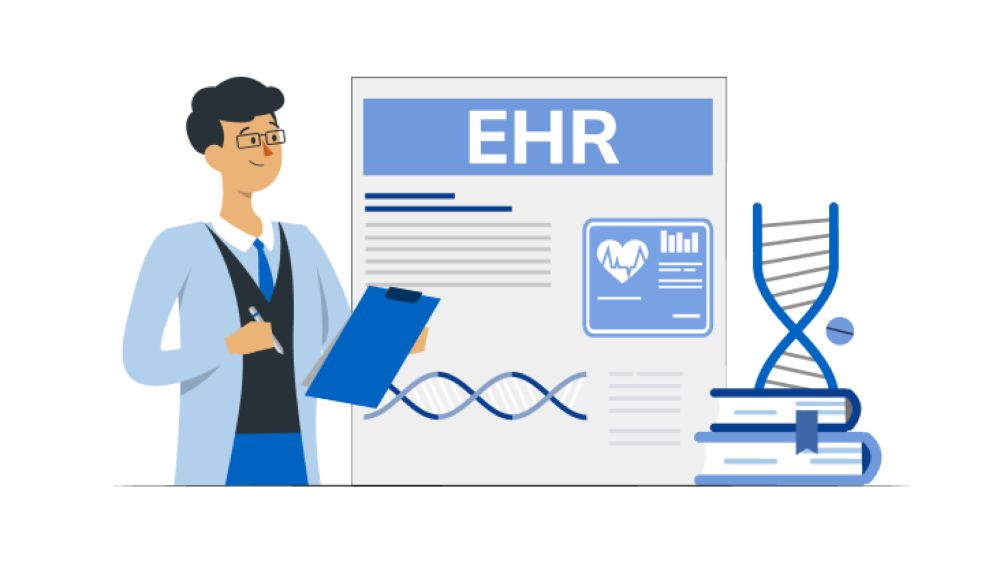Data is key to healthcare technology development, creating better treatments, and improving patient care.
This guide will introduce you to the various kinds of data, from medical records to personal health information, and explain how they can help make healthcare more effective and focused on the patient. Get ready to discover how each type of data contributes to making healthcare smarter and more responsive to patient and provider needs.
1. Electronic Health Records and Electronic Medical Records
Electronic health records (EHR), and electronic medical records (EMRs) are two key types of healthcare data that have fundamentally transformed how healthcare providers manage patient information. EMR data refers to the digital version of a patient’s paper chart in a clinician’s office, encompassing medical and treatment histories within one practice. EHR data, on the other hand, takes this concept a step further by offering a more comprehensive and holistic view of the patient’s health.

EHRs are designed to share information with other healthcare providers and organizations—such as laboratories, specialists, medical imaging facilities, pharmacies, emergency facilities, and clinics— ensuring that a patient’s health information is accessible and securely shared across different healthcare settings. This seamless exchange of information not only improves the accuracy of diagnoses and treatment plans but also enhances the overall quality of care by making the patient’s health history easily accessible to all authorized providers involved in their care.
2. Administrative Data
Healthcare administrative data is generated during each interaction with the healthcare system, be it a visit to a doctor’s office, a diagnostic procedure, hospital admission, interactions with care facilities, home care, or filling pharmaceutical prescriptions.
This data is gathered for administrative or billing reasons, but can also be utilized to analyze healthcare delivery, advantages, disadvantages, and cost-effectiveness. In certain areas, such data includes details on hospital discharge information that will later be reported to the government or other entities.

These types of healthcare data primarily cover financial and activity-tracking data, which serve as key components for various monitoring strategies.
3. Claims Data
Claims data includes the billable interactions between insured patients and the healthcare delivery system, mostly for coverage or compensation. Claims contain information on patient diagnoses, procedures and tests conducted, dates of services, costs, and where services were rendered. The data typically includes:
- Diagnosis Codes (“ICD-10”): Standardized codes that illustrate patient conditions, assisting in analyzing trends and allocating resources.
- Procedure Codes (“CPT”): Standardized codes for medical services, assisting in efficient billing, resource allocation, and assessment of treatments.
- National Provider Identifier (NPI): Distinct identifiers that guarantee accurate reimbursement and clearness for healthcare providers during transactions.
- Service Dates: Documented times of services rendered to help monitor patient care, streamline workflows, and improve health outcomes.

Leveraging claims data alongside other real-world data opens up new avenues for healthcare research. This allows for a range of innovative applications, such as evaluating the effectiveness of treatments, tracking disease outbreaks, and improving medication safety. These insights provide a deeper understanding of patients’ real-life experiences and healthcare protocols.
4. Patient / Disease Registries
Patient/disease registries are collections of secondary data associated with patients who are diagnosed with a specific condition, disease, or procedure. These data are essential for post-marketing surveillance of pharmaceuticals.
Clinical information systems monitor essential data for chronic conditions such as Alzheimer’s, cancer, diabetes, heart disease, and asthma. These sources of information offer crucial insights for handling and monitoring patient conditions. Instances of disease registries are the Global Alzheimer’s Association Interactive Network or the National Program of Cancer Registries.

Commonly, registries differ in complexity, ranging from basic spreadsheets restricted to a limited group of physicians to intricate online databases accessible across various organizations. These registries can also act as reminders for healthcare providers (and sometimes patients) to conduct specific tests for specific healthcare demands.
5. Health Surveys
National health surveys assess the health of the population and estimate disease prevalence. These data outlets are curated for research objectives and are broadly available. Examples of this data type include the National Medical Expenditure Survey, the Medicare Current Beneficiary Survey, and the National Health & Nutrition Examination Survey.
Health surveys stand at the forefront in the decision-making of formulating health plans, offering accurate data on epidemiological status, health patterns, lifestyle behaviors, and patients’ experience with healthcare services.

Public health researchers utilize health survey data to analyze health-related behaviors and psychological wellness. Health surveys are also valuable for identifying specific health conditions or risk factors within the community near healthcare facilities, including tobacco and alcohol use, unhealthy diet plans, and physical inactivity.
6. Clinical Trial Data
Clinical trial data stems from research studies that evaluate medical, surgical, or behavioral treatments in patients. These data points serve as the primary method for researchers to:
- Explore methods for early disease detection, often prior to symptoms
- Discover strategies to take preventive actions for specific health issues, even for seemingly healthy people
- Enhance the quality of life for patients coping with a severe illness or chronic health conditions
- Improve the performance of health professionals and caregivers

Throughout a clinical trial, various types of data are collected and converted into analyzable datasets to tackle different research inquiries. Clinical trial data may thenbe utilized in various publications and reports for varying audiences.
There are various registries that provide access to databases of clinical trials, such as ClinicalTrials.gov, OpenTrials, and the WHO International Clinical Trials Registry Platform.
7. Genomic Data
Genomic data contains the arrangement and operation of an organism’s genome, which includes all the cellular data necessary for its growth and operation. This data involves details such as the molecular sequence in an organism’s genes, the role of each gene, the regulatory elements managing gene expression, and the connections among various genes.

Genomic information serves as the basis for genomic data science, merging genetics and computational biology studies with statistical data analysis and computer science. For instance, genomic data researchers utilize DNA sequence data to investigate diseases and uncover new treatments and medications.
This data is collected to demonstrate how genetic data influences the growth and operation of organisms, thereby aiding research in life sciences, diagnosing genetic diseases, and developing medicines.
Tips for Accessing Different Types of Healthcare Data

1. Define the Healthcare Data Needed for Your Project
Defining the right healthcare data needed and what is available can assist in keeping the project objectives in sight, rather than getting caught up in the initial data access or sharing phase. Healthcare data infrastructure can differ greatly among organizations, underscoring the importance of evaluating the systems within your setting.
Reviewing current data sources also involves evaluating the data for its quality, comprehensiveness, and suitability for your specific needs. Take into account the data owner’s ability to provide information, data dictionaries, tracking mechanisms, data collecting approaches, as well as data validity and reliability.
Make sure your organization is equipped with the right infrastructure to securely handle data that might be shared. If it’s not ready to manage sensitive information like EHR data, which is strictly regulated by HIPAA, then consider exploring other types of data that align better with your organizational capabilities.
2. Develop Multi-sector Partnerships
Finding healthcare data entities and systems in your area might pose challenges, yet collaborating with insurers, academic institutions, health departments, local governing bodies, and technology vendors can enhance your understanding of local health and public healthcare data.
Within public health and health care, build relationships with staff at different levels, including data analysts, population health managers, epidemiologists, community benefits directors, administrators, care managers, and others. For public health, start by learning about the community health improvement process and opportunities to get involved.
Building collaborations can be time-consuming, but it is an important step to set a common vision before specific projects are realized.
KMS Healthcare is here to help you clear the integration backlogs and enhance your healthcare data systems while you focus on building these crucial multi-sector partnerships.

3. Keep in Mind The Regulations on Healthcare Data Sharing
Dealing with healthcare data-sharing rules can be tricky and might need advice from experts. Instead of thinking that HIPAA rules will slow you down, take a close look to make sure your plans follow the rules. This helps you keep your data secure while moving your project forward.
The legal complexities related to sharing healthcare data may necessitate consultation from healthcare experts. A tip here is that rather than presuming HIPAA will hinder your project progress, thoroughly explore whether your strategies are compliant so that you can also build a secure environment for your data.
FAQs
1. What types of healthcare data are commonly used in medical research?
The datasets used by medical researchers come from a variety of different sources; the most common ones are:
- Patient data from hospital and primary care administrative details to treatment specifics, medical and diagnostic procedures.
- Research on the well-being of populations, whether focused on a specific health ailment like cancer or factors impacting public health such as smoking.
- Genetic information that can be extracted from blood or tissue samples.
- Information-rich images like X-rays, MRIs, and CT scans.
- IOMT wearable devices for health and fitness that provide data on metrics such as heart rate, physical activity, and calories.
2. Are there specific standards for managing different types of healthcare data?
There are more than 40 standards development organizations operating in the US healthcare field. Among the widely acknowledged standards are:
- FHIR – Fast Healthcare Information Resources
- HL7 — Health Level 7 International
- NCDPD — National Council for Prescription Drug Programs
- IHTSDO — International Health Terminology Standards Development Organizations
- DirectTrust Standards
- CDISC — Clinical Data Interchange Standards Consortium
The primary standards established by these standards development organizations that are commonly used among healthcare entities can be categorized into four major groups:
- Terminology standards
- Content standards
- Data exchange or transport standards
- Privacy and security standards.
3. What are the formats of healthcare data?
Healthcare data is stored and displayed in one of the following formats:
Structured data: Structured data refers to information gathered and stored in a well-organized, frequently standardized manner. Structured data plays a vital role in enabling the comparison and consolidation of data elements among patients, healthcare providers, and payers.
Unstructured data: Free text or image data like progress reports, clinical notes, and radiology images are often stored as unstructured data in medical records. The bulk of healthcare data is stored in this form, posing challenges for consolidation and cross-system comparisons.
Leveraging Data for HealthTech Innovation with KMS Healthcare
How is your organization using the data it has access to? With the rise of generative AI and other logic-based advancements, we are seeing more healthcare organization than ever start to think about how to use various types of healthcare data more efficiently in their staffing, processes, and technology to make changes in healthcare delivery.
However, not every healthcare provider can afford to hire data experts or set up a big data system. That’s where KMS Healthcare steps in. We’re proud to be a top healthcare tech company, offering solutions that let organizations make the most of their data securely, and in compliant environments.
With over 15 years in the healthcare field, we promise to help you use your data effectively through a solid data strategy, a powerful analytics setup, and innovative uses of data to better serve your patients.
In the next ten years, the key difference between healthcare providers will be how they use data. Those who make data-driven decisions will come out ahead. Reach out to us and start making the most of your data today.

Reference
(n.d.). How to Navigate Structured and Unstructured Data as a Healthcare Organization. HealthTech Magazine. https://healthtechmagazine.net/article/2023/05/structured-vs-unstructured-data-in-healthcare-perfcon
(n.d.). How Health Systems Can Connect Clinicians to Data More Quickly. HealthTech Magazine. https://revcycleintelligence.com/news/denial-management-calls-for-more-expertise-survey-says
(n.d.). Using Administrative Data for Monitoring and Evaluation. GOLDILOCKS DEEP DIVE. https://poverty-action.org/sites/default/files/publications/Goldilocks-Deep-Dive-Using-Administrative-Data-for-Monitoring-and-Evaluation_1.pdf